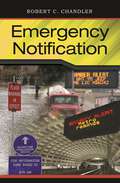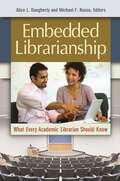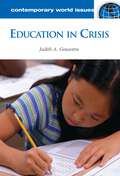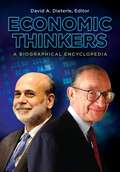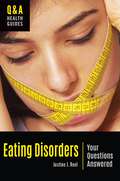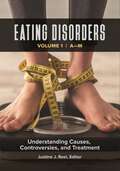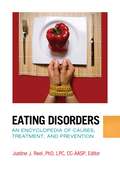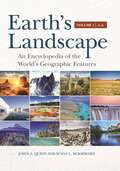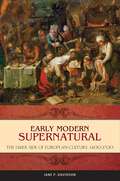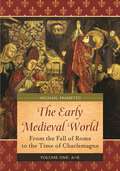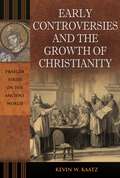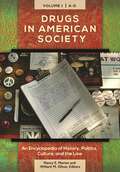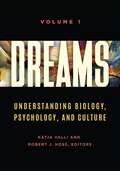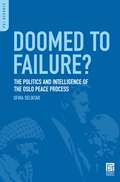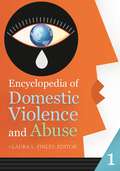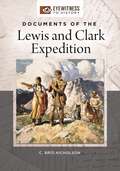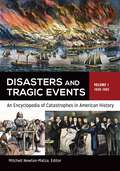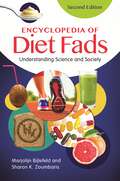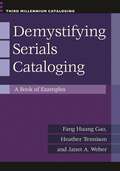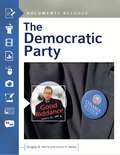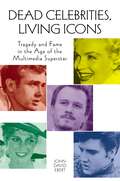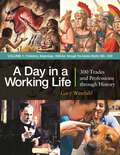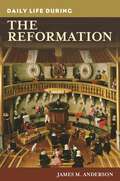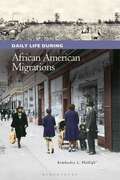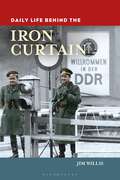- Table View
- List View
Emergency Notification (PSI Business Security)
by Robert C. ChandlerThis text provides critical information to help organizations improve their emergency communications, including the tools, automation technology, and processes of crisis notification.To grasp the importance of emergency notification, imagine this scenario: A shooter is on the loose at a college campus. Chaos reigns. To contain the situation, campus personnel need to communicate immediately and efficiently, not only with the students, faculty, and staff, but also the local police, federal law enforcement, and media. Effective emergency notification makes things "right," it allows the right message to reach the right people at the right time—facilitating the right response. Emergency Notification explains how.This book offers must-know information for business security, senior management, human resources staff, government policymakers, and emergency planners, examining what, when, how, why, and with whom to communicate during crises. This text also covers risk communication, message mapping, information loading, audience comprehension, and practical issues like testing emergency notification systems.
Embedded Librarianship: What Every Academic Librarian Should Know
by Alice L. Daugherty and Michael F. RussoIn the ongoing evolution of the academic library, embedded librarianship has become an important topic of debate across levels and departments. This book delves into the concept, examining everything from theory to best practices.Is the embedded librarian an equal partner in the course, or is the librarian perceived as a "value-added" extra? What is the place of technology in this effort? Is there a line librarians should not cross? Taking into account both theory and practice to discuss multiple facets of the subject, Embedded Librarianship: What Every Academic Librarian Should Know thoroughly examines these questions and more from the perspectives of experienced embedded librarian contributors who have worked in higher education settings. The chapters illuminate the benefits and challenges of embedding, explain the planning required to set up an embedded course, identify the different forms of embedding, and consider information literacy instruction in various contexts.Readers who will benefit from this work include not only academic librarians but any professor who wants their students to be able to do better research in their fields.
Education in Crisis: A Reference Handbook (Contemporary World Issues)
by Judith A. GouwensA description and critique of education reform in the United States since the 1950s, focusing on the current condition of American schools and efforts to increase both educational opportunity and overall excellence.Authoritative and objective, Education in Crisis: A Reference Handbook is a critical look at the current state of the American school system, the conditions that have led many to label it "in crisis," and solutions aimed at leveling the educational playing field, elevating overall student achievement, and keeping American students competitive on the world stage.Education in Crisis shows how competing economic, political, philosophical, psychological, and global interests have influenced American education reform. It then covers a range of reform initiatives, including magnet schools, basic skills curriculum, home schooling, and the role of technology. A comparison of the U.S. education system to those of other countries and a presentation of helpful resources round out this essential volume for educators, policymakers, parents, and anyone concerned about the nation's schools.
Economic Thinkers: A Biographical Encyclopedia
by David A. DieterleWho are the individuals whose novel ideas, writings, and philosophies have influenced economics throughout history—and in doing so, have helped change the world? This encyclopedia provides a readable study of economics by examining the great economists themselves.This book presents biographies of 200 economic thinkers throughout history, supplying a one-stop reference about the men and women whose ideas, writings, and philosophies created the foundation of our current understanding of economics. Depicting their subjects within the contexts of history, development economics, and econometrics, these biographies provide an insightful overview of the world of economics through the economists of significance and the many subdisciplines, topics, eras, and philosophies they represent.Economic Thinkers: A Biographical Encyclopedia begins by describing economic thinkers in ancient Greece and Rome, moves through history to cover economists in the 15th through 19th centuries, and addresses economic theory in the 20th century and the modern era. Written to be easily accessible and highly readable, the work will appeal to students, scholars, general readers, and anyone interested in learning about the historical and philosophical foundation of economics.
Eating Disorders: Your Questions Answered (Q&A Health Guides)
by Justine J. ReelThis book is an approachable introduction to eating disorders; one of the most common—and dangerous—forms of mental illness. The information, guidance, and resources offered make it a valuable tool for anyone struggling with issues surrounding food, weight, and body image.In the United States today, an estimated 20 million women and 10 million men meet the diagnostic criteria for an eating disorder, and millions more have disordered eating habits and a dysfunctional relationship with food. Whether their disorder is diagnosed or not, individuals struggling with these issues face serious and potentially lifelong physical and emotional consequences as a result of their behaviors. Eating Disorders: Your Questions Answered, a part of Greenwood's Q&A Health Guides series, provides clear, concise information for readers who want to learn more about these often misunderstood psychiatric illnesses. In addition to discussing the most common eating disorders, their consequences, and treatment, this book also explores how eating disorders develop and how they can be prevented.Each book in this series follows a reader-friendly question-and-answer format that anticipates readers' needs and concerns. Prevalent myths and misconceptions are identified and dispelled, and a collection of case studies illustrates key concepts and issues through relatable stories and insightful recommendations. The book also includes a section on health literacy, equipping teens and young adults with practical tools and strategies for finding, evaluating, and using credible sources of health information both on and off the internet—important skills that contribute to a lifetime of healthy decision-making.
Eating Disorders [2 volumes]: Understanding Causes, Controversies, and Treatment [2 volumes]
by Justine J. ReelThis encyclopedia offers a variety of resources for readers interested in learning more about eating disorders, including hundreds of reference entries, interviews, scholarly debates, and case studies.While many people may reflexively imagine an anorexic or bulimia teenage girl upon being asked to think about eating disorders, eating disorders are a form of mental illness that can take many forms and affect individuals of all genders, ages, and ethnic backgrounds. In fact, an estimated eight million people in the United States struggle with an eating disorder, making eating disorders one of the most prevalent forms of mental illness in America. This two-volume encyclopedia comprehensively examines eating disorders as the forms they can take; their causes and potential complications; and how they can best be treated and prevented. It also examines the influence had by cultural factors such as the fashion industry, television and movies, and social media. More than just a simple A-to-Z reference, Eating Disorders: Understanding Causes, Controversies, and Treatment also includes valuable features such as Q&A interviews with those affected by and working to combat eating disorders, case studies, scholarly essays that voice opinions in key debates, and a directory of resources for individuals seeking help.
Eating Disorders: An Encyclopedia of Causes, Treatment, and Prevention
by Justine J. ReelA timely, relevant work, this encyclopedia provides a comprehensive examination of a full range of topics related to eating disorders and body image.The mortality rate associated with eating disorders is higher than that of any other psychiatric illness. What are the factors that influence abnormal perceptions of body image and trigger the deadly behaviors of food deprivation or uncontrollable gluttony? This indispensable resource thoroughly examines the complex subject of eating disorders, particularly the sociocultural, psychological, and nutritional aspects of eating disorders and body image.Eating Disorders: An Encyclopedia of Causes, Treatment, and Prevention explores the definitions, risk factors, symptoms, and health consequences of such illnesses as anorexia, bulimia, and binge eating. The author discusses the assessment and treatment of these conditions, and imparts health education strategies related to the "Dos and Don'ts" of awareness and prevention efforts. Additionally, she shares tips for recognizing symptoms and discusses where to seek help if a friend or family member is affected. Topics include flight attendants and body weight requirements, the impact of Virtual Reality, and media and sociocultural influences.
Earth's Landscape [2 volumes]: An Encyclopedia of the World's Geographic Features [2 volumes]
by Joyce A. Quinn Susan L. WoodwardThis unusual encyclopedia brings together in-depth information on more than 450 natural geographic features from around the world and offers an array of creative tools to promote critical thinking and classroom discussion.With Earth undergoing rapid environmental change, students and the general public alike should be knowledgeable about the world's geographic features. This authoritative, two-volume reference enables readers do just that. It describes continents and oceans; individual mountains, islands, caves, and rivers; and ecological entities such as wildlife refuges and national parks. Each entry provides a geographic overview of the feature's significance, location, description, geologic history, biota, protected areas, and environmental issues. But the coverage goes even deeper so that entries also discuss the cultural importance of each natural place, covering everything from indigenous beliefs to traditional folklore to contemporary legends.The encyclopedia stands apart from other works not only in the depth of its coverage but also in its range. It discusses lesser known as well as prominent geographical features and offers critical thinking aids that will help students see how the natural world relates to their daily lives. Teaching and learning tools include an appendix called "Opposing Viewpoints" that allows students to understand landforms involved in current conflicts and disputes as well as an "Activities/Discussion Questions" appendix.
Early Modern Supernatural: The Dark Side of European Culture, 1400–1700 (Praeger Series on the Early Modern World)
by Jane P. DavidsonDevils, ghosts, poltergeists, werewolves, and witches are all covered in this book about the "dark side" of supernatural beliefs in early modern Europe, tapping period literature, folklore, art, and scholarly writings in its investigation.The dark side of early modern European culture could be deemed equal in historical significance to Christianity based on the hundreds of books that were printed about the topic between 1400 and 1700. Famous writers and artists like William Shakespeare and Albrecht Dürer depicted the dark side in their work, and some of the first printed books in Europe were about witches. The pervasive representation of these monsters and apparitions in period literature, folklore, and art clearly reflects their power to inspire fear and superstition, but also demonstrates how integral they were to early modern European culture.This unique book addresses topics of the supernatural within the context of the early modern period in Europe, covering "mythical" entities such as devils, witches, ghosts, poltergeists, and werewolves in detail and examining how they fit in with the emerging new scientific method of the time. This unique combination of cultural studies for the period is ideal for undergraduate students and general readers.
The Early Medieval World [2 volumes]: From the Fall of Rome to the Time of Charlemagne [2 volumes]
by Michael FrassettoThis book examines a pivotal period in ancient human history: the fall of the Roman Empire and the birth of a new European civilization in the early Middle Ages.The Early Medieval World: From the Fall of Rome to the Time of Charlemagne addresses the social and material culture of this critical period in the evolution of Western society, covering the social, political, cultural, and religious history of the Mediterranean world and northern Europe. The two-volume set explains how invading and migrating barbarian tribes—spurred by raiding Huns from the steppes of Central Asia—contributed to the fall of the Western Roman Empire, and documents how the blending of Greco-Roman, Germanic, and Christian cultures birthed a new civilization in Western Europe, creating the Christian Church and the modern nation-state. A-Z entries discuss political transformation, changing religious practices in daily life, sculpture and the arts, material culture, and social structure, and provide biographies of important men and women in the transitional period of late antiquity. The work will be extremely helpful to students learning about the factors that contributed to the decline of the Roman Empire—an important and common topic in world history curricula.
Early Controversies and the Growth of Christianity (Praeger Series on the Ancient World)
by Kevin W. KaatzThis revealing history examines the controversies, maneuvering, and political wrangling that occupied the Christian Church for the first four centuries of its existence.Drawing from primary texts, Early Controversies and the Growth of Christianity reveals how the religion was formed through a series of conflicts that occurred primarily between Christian groups. Presenting a close examination of the first four centuries of Christian history through the lens of the controversies that animated, disturbed, and finally formed the Church, the book will enable readers to become familiar with the lives and writings of the early Christians and to better understand the fascinating history of early Christianity.The book focuses on several major early controversies. These include controversies surrounding the apostle Paul; controversies concerning the apostolic fathers, especially the idea of a pope and the role of the bishop/priest; Marcion and his influence; Manichaeism and Gnosticism; persecution and the Dontatists; Arianism; the rise of the bishop in the late 4th century; and power struggles between church and state. Each chapter focuses on the primary texts and key players in the battle over what would finally become orthodox Christianity, demystifying many poorly understood events that ultimately helped define today's Church.
Drugs in American Society [3 volumes]: An Encyclopedia of History, Politics, Culture, and the Law [3 volumes]
by Nancy E. Marion and Willard M. Oliver, EditorsContaining more than 450 entries, this easy-to-read encyclopedia provides concise information about the history of and recent trends in drug use and drug abuse in the United States—a societal problem with an estimated cost of $559 billion a year.Despite decades of effort and billions of dollars spent to combat the problem, illicit drug use in the United States is still rampant and shows no sign of abating. Covering illegal drugs ranging from marijuana and LSD to cocaine and crystal meth, this authoritative reference work examines patterns of drug use in American history, as well as drug control and interdiction efforts from the nineteenth century to the present.This encyclopedia provides a multidisciplinary perspective on the various aspects of the American drug problem, including the drugs themselves, the actions taken in attempts to curb or stop the drug trade, the efforts at intervention and treatment of those individuals affected by drug use, and the cultural and economic effects of drug use in the United States. More than 450 entries descriptively analyze and summarize key terms, trends, concepts, and people that are vital to the study of drugs and drug abuse, providing readers of all ages and backgrounds with invaluable information on domestic and international drug trafficking and use. The set provides special coverage of shifting societal and legislative perspectives on marijuana, as evidenced by Colorado and Washington legalizing marijuana with the 2012 elections.
Dreams [2 volumes]: Understanding Biology, Psychology, and Culture [2 volumes]
by Katja Valli, Robert J. Hoss and Robert P. GongloffThis two-volume set examines dreams and dreaming from a variety of angles—biological, psychological, and sociocultural—in order to provide readers with a holistic introduction to this fascinating subject.Whether good or bad and whether we remember them or not, each night every one of us dreams. But what biological or psychological function do dreams serve? What do these vivid images and strange storylines mean? How have psychologists, religions, and society at large interpreted dreams, and how can a closer examination of our dreams provide useful insights?Dreams: Understanding Biology, Psychology, and Culture presents a holistic view of dreams and the dreaming experience that answers these and many other questions. Divided thematically, this two-volume book examines the complex and often misunderstood subject of dreaming through a variety of lenses. This collection is written by a large and diverse team of experts and edited by leading members of the International Association for the Study of Dreams (IASD) but remains an approachable and accessible introduction to this captivating topic for all readers.
Doomed to Failure?: The Politics and Intelligence of the Oslo Peace Process (PSI Reports)
by Ofira SeliktarThis ground-breaking book examines how and why the much-vaunted Oslo Peace Accords between the Israelis and Palestinians collapsed. The author analyzes the players on both sides of the accords, pointing out the attitudes and actions that serve to undermine peace and promote conflict. On the one hand, she criticizes the Islamist organizations Hamas and Palestinian Islamic Jihad for not tolerating the idea of any true long-term peace with Israel. On the other hand, she scrutinizes the factions for and against Oslo that developed within Israeli government circles, and she calls into question the ability of Israeli intelligence to correctly assess the Palestinian negotiators. By means of such examination, this book poses a fundamental question: Can Islamic fundamentalism ever accept the existence of Israel or will it short-circuit any prospect of peace between majority-Muslim states and their non-Muslim counterparts?
Encyclopedia of Domestic Violence and Abuse [2 volumes]: [2 volumes]
by Laura L. Finley Natasha A. Abdin Nathan Andrews Megan H. Bair-Merritt Kristin A. Bell Kimberly Bellon Elizabeth Biebel Allison Brimmer Sade Brooks Samuel L. Browning Eduin Caceres-Ortiz Stephanie Chaban AnneMarie Conlon Jennifer Cote Tatyana Cottle Peter F. Cronholm Antje Deckert Andrea J. Dickens Jessica J. Eckstein Maria F. Espinola Renee Fillette Kristin Franklin Brandon Fryman Dr Tony Gaskew Lynn Geurin Chuck Goesel Kathryn Goesel Lynsay Gott Kori A. Hakala KaaVonia Hinton-Johnson Andrew Hund Mark Ikeke Njoki Kinyatti Denice Knight-Slater Stephanie A. Kolakowsky-Hayner Carol Lenhart Jennifer Rey Alison Marganski Mark Marquez Vanessa Marquez Alison Mulcahy Shondrah Tarrezz Nash Catherine Ekwe Kate Ngozi Cheryl O’Brien Patricia Marla Perkins Lauren Pilnick William Plouffe Sabrina Robin C. Sager Jeff Shantz Amanda Mathisen Stylianou Sharon Thiel Vincent B. Van Hasselt Stephanie Van Hook W. Jesse Weins Ashley Wiegand Jackie Wiersma Hakim Mohandas Amani Williams Fatima ZimichiThis comprehensive, two-volume work examines domestic abuse in the United States and worldwide, providing research, personal stories, and primary documents that reveal the extent of the problem.An estimated 1,300 to 1,800 Americans are murdered by intimate partners each year. Far from being a problem that only impacts women, domestic violence hurts society as a whole both socially as well as financially, with an estimated direct and indirect cost of nearly $6 billion annually in the United States. This book provides a timely and thorough reference for educators, students, scholars and activists seeking to better understand the global issue of domestic abuse. The entries document the history of the domestic violence prevention movement, provide explanations for abuse, identify warning signs of hidden abuse, describe types of victims and offenders, and supply information on interventions and prevention programs. Written by an array of experts in the field, the book also integrates the personal stories of survivors and addresses abuse as a global issue by covering topics such as acid attacks and female genital mutilation.
Documents of the Lewis and Clark Expedition (Eyewitness to History)
by C. Bríd NicholsonThrough its extensive use of primary source materials and invaluable contextual notes, this book offers a documented history of one of the most famous adventures in early American history: the Lewis and Clark expedition.This book is the first to situate the Lewis and Clark expedition within the political and scientific ambitions of Thomas Jefferson. It spans a forty-year period in American history, from 1783–1832, covering Jefferson's early interest in trying to organize an expedition to explore the American West through the difficult negotiations of the Louisiana Purchase, the formation of the "Corps of Discovery," the expedition's incredible journey into the unknown, and its aftermath. The story of the expedition is told not just through the journals and letters of Lewis and Clark, but also through the firsthand accounts of the expedition's other members, which included Sacagawea, a Native American woman, and York, an African American slave. The book features more than 100 primary source documents, including letters to and from Jefferson, Benjamin Rush, and others as the expedition was being organized; diary excerpts during the expedition; and, uniquely, letters documenting the lives of Lewis, Clark, Sacagawea, and York after the expedition.
Disasters and Tragic Events [2 volumes]: An Encyclopedia of Catastrophes in American History [2 volumes]
by Mitchell Newton-MatzaFrom the Salem Witch Trials of 1692 to the Sandy Hook school massacre of 2012, this two-volume encyclopedia surveys tragic events—natural and man-made, famous and forgotten—that helped shape American history.Tragedies and disasters have always been part of the fabric of American history. Some gave rise to reactions that profoundly influenced the nation. Others dominated public consciousness for a moment, then disappeared from collective memory. Organized chronologically, Disasters and Tragic Events examines these moments, covering both the familiar and the obscure and probing their immediate and long-term effects. Unlike other works that concentrate on a particular type of disaster, for example, weather- or medicine-related tragedies, this two-volume encyclopedia has no such limits. Its entries range from natural disasters, such as hurricanes and tornadoes, to civic disturbances, environmental disasters, epidemics and medical errors, transportation accidents, and more. The work is a perfect supplement for history classes and will also prove of great interest to the general reader.
Encyclopedia of Diet Fads: Understanding Science and Society
by Marjolijn Bijlefeld Sharon K. ZoumbarisThis updated encyclopedia examines the basics of nutrition and dieting, presenting the important people, concepts, and criticisms involved and examining the pros and cons of different plans.This A-to-Z reference describes many of the health fads and fashions of the past as well as current trends in weight loss to help people understand the principles of weight loss and the benefits of healthy choices. The authors help to identity effective means of losing weight and maintaining a healthy lifestyle, placing particular emphasis on weight-loss programs aimed at young people who struggle most with obesity, eating disorders, and body image. The book explores what works, what is potentially dangerous, and what scientists are discovering about nutrition, while also offering sustainable advice for keeping fit.The second edition of Encyclopedia of Diet Fads includes many updated, expanded, and completely new entries, as well as the latest information on diets and reviews many popular diet trends like the Atkins Diet, the Zone Diet, Weight Watchers, and Medifast. The book is organized by alphabetical entries regarding nutrition, exercise, and famous and infamous diet-promoters. Readers can learn more about an area that interests them through cross-referenced sections and a prolific list of additional resources. A selection of appendixes contains practical information such as how to evaluate diets and recipes.
Demystifying Serials Cataloging: A Book of Examples (Third Millennium Cataloging)
by Fang Huang Gao Heather Tennison Janet A. WeberThis essential reference teaches library staff how to handle the most common and confusing problems in serials cataloging by providing clear examples, practice exercises, and helpful advice based on experience.Serials cataloging can be an overwhelming task that frustrates even the most seasoned professional. This book provides simple guidance and real-world examples to illustrate best practices in serials cataloging.Demystifying Serials Cataloging: A Book of Examples is a reliable reference for learning how to catalog serials or improve cataloging skills. The book covers important elements of descriptive cataloging of serial publications such as explanations, sample records, applicable cataloging rules, and images of the serials. Examples demonstrate best practices and guidelines from the industry's leading cataloging standards including Anglo-American Cataloguing Rules: Second Revised Edition; CONSER Cataloging Manual; Library of Congress Rule Interpretation; and OCLC Bibliographic Formats and Standards. Each chapter contains helpful practice exercises to ensure understanding and reinforce learning.
The Democratic Party: Documents Decoded (Documents Decoded)
by Douglas B. Harris Lonce H. BaileyThrough an examination of key historical documents, this book chronicles the Democratic Party's complete transformation from the small-government, Jeffersonian party to a party of activist government and social progressivism during the presidencies of Franklin D. Roosevelt, Lyndon Johnson, Bill Clinton, and Barack Obama.What are the objectives of today's Democratic Party, and what historic events have guided its evolution from a decidedly different ideological starting point more than 200 years ago? The Democratic Party: Documents Decoded supplies a thorough historical examination of the Democratic Party from its distant origins in George Washington's administration to the two-term administration of Barack Obama. Told through key documents and speeches, this history comes alive in the words and thoughts of those who built, sustained, and transformed the Democratic Party. No other book uses documents in this way to tell a comprehensive history of this party.The book utilizes primary documents to investigate a breadth of topics such as the Democratic party's positions on civil rights, discrimination, voting rights, taxation, representation, immigration, primary elections, caucuses, the Republican opposition, relations between church and state, the role of government, and foreign policy. The scholarly commentary provides essential context that bridges the gaps between documents and insightful explanations and clarifications of specific passages or terms to ensure reader comprehension. A work unlike any other on the history of the Democratic Party, this book will serve advanced high school students in government and history classes as well as undergraduate students taking courses in political science and history.
Dead Celebrities, Living Icons: Tragedy and Fame in the Age of the Multimedia Superstar
by John David EbertThis in-depth series of literary portraits studies celebrities who died in famous and tragic ways—ways that still resonate as archetypal death scenarios in present day.We know their likes and dislikes, admire their talents, envy them for daring to be what we can't or what we won't. When they are snatched from us, we feel a personal loss and an unwillingness to let go. And so we transform these mere human beings into icons whose stars often shine in death even more brilliantly than in life.Dead Celebrities, Living Icons: Tragedy and Fame in the Age of the Multimedia Superstar explores this phenomenon through a series of essays on 14 men and women who are, arguably, the most famous people of the 20th and early 21st centuries. The book covers the epoch of the celebrity beginning in the 1930s with Howard Hughes and Walt Disney and continues to the present day with the life and death of Michael Jackson. Far more than just a collection of biographies, Dead Celebrities, Living Icons documents the philosophical importance and significance of the contemporary cult of the celebrity and analyzes the tragic consequences of a human life lived in the glare of the media spotlight.
A Day in a Working Life [3 volumes]: 300 Trades and Professions through History [3 volumes]
by Gary WestfahlIdeal for high school and college students studying history through the everyday lives of men and women, this book offers intriguing information about the jobs that people have held, from ancient times to the 21st century.This unique book provides detailed studies of more than 300 occupations as they were practiced in 21 historical time periods, ranging from prehistory to the present day. Each profession is examined in a compelling essay that is specifically written to inform readers about career choices in different times and cultures, and is accompanied by a bibliography of additional sources of information, sidebars that relate historical issues to present-day concerns, as well as related historical documents.Readers of this work will learn what each profession entailed or entails on a daily basis, how one gained entry to the vocation, training methods, and typical compensation levels for the job. The book provides sufficient specific detail to convey a comprehensive understanding of the experiences, benefits, and downsides of a given profession. Selected accompanying documents further bring history to life by offering honest testimonies from people who actually worked in these occupations or interacted with those in that field.
Daily Life during the Reformation (The Greenwood Press Daily Life Through History Series)
by James M. AndersonThis broad exploration captures the lives of ordinary people during the turbulent period that transformed early Modern Europe.Organized thematically, Daily Life during the Reformation covers the hectic and tumultuous years between 1517 and 1648, allowing readers to discover what it was like for ordinary people during this critical period and to compare events and living conditions in early Modern Europe with those of today. With the help of eyewitness accounts, the book focuses on the lives of the people, the conditions in which they lived and died, their roles in the unfolding events of the Reformation, and the Reformation's effects on them. Leading protagonists are described, as are their beliefs and the impact of those beliefs on the population in general and in particular cases. The book also explores, for example, the medical practice of the time, which, while not considered black magic, was close to it.
Daily Life during African American Migrations (The Greenwood Press Daily Life Through History Series: Daily Life in the United States)
by Kimberley L. PhillipsThis book examines the century-long migration of African Americans who moved within the South after the Civil War and then left to settle permanently in other regions, irrevocably altering the political, social, and cultural history of the United States; and considers these movements within the broader historical, political, and cultural context of the African Diaspora.Daily Life during African American Migrations focuses attention to the everyday social, cultural, and political lives of migrants in the United States as they established communities far away from their former homes. This book examines blacks' labor and urban experiences, social and political activism, and cultural and communal identities, while also considering the specificity of African Americans' migration as part of their long struggle for freedom and equality.The author merges information from black migration studies, which focus on the internal movement of African American people in the United States, with African Diaspora studies, which consider peoples of African descent who have settled far from their native homes—either voluntarily or through duress—to document how these immigrants and their children create new communities while maintaining cultural connections with Africa. The stories of the nine million African Americans who collectively left the South between 1865 and 1965—and the millions more who left the Caribbean and Africa—not only document this long history of migration, but also present compelling human drama.
Daily Life behind the Iron Curtain (The Greenwood Press Daily Life Through History Series)
by Jim WillisThis compelling book describes how everyday people courageously survived under repressive Communist regimes until the voices and actions of rebellious individuals resulted in the fall of the Iron Curtain in Europe.Part of Greenwood's Daily Life through History series, Daily Life behind the Iron Curtain enables today's generations to understand what it was like for those living in Eastern Europe during the Cold War, particularly the period from 1961 to 1989, the era during which these people—East Germans in particular—lived in the imposing shadow of the Berlin Wall.An introductory chapter discusses the Russian Revolution, the end of World War II, and the establishment of the Socialist state, clarifying the reasons for the construction of the Berlin Wall. Many historical anecdotes bring these past experiences to life, covering all aspects of life behind the Iron Curtain, including separation of families and the effects on family life, diet, rationing, media, clothing and trends, strict travel restrictions, defection attempts, and the evolving political climate. The final chapter describes Eastern Europe after the fall of the Berlin wall and the slow assimilation of East into West, and examines Europe after Communism.
